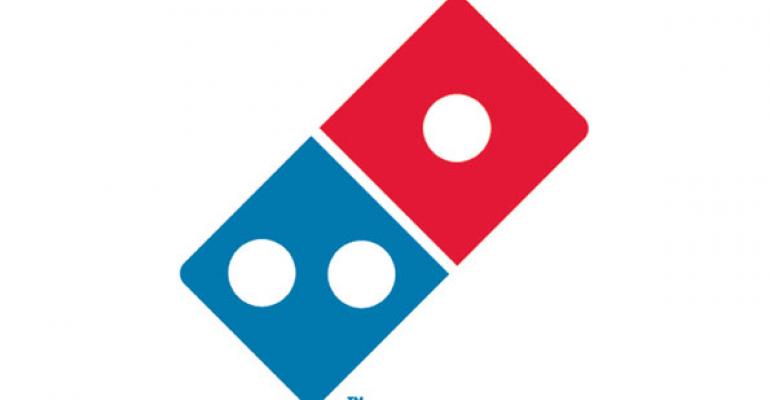Domino’s Pizza Inc. stock hit an all-time high on Thursday after reporting a domestic same-store sales increase of 10.7 percent in the fourth quarter ended Jan. 3.
The sales surge, capping a year in which U.S. same-store sales grew 12 percent, came despite improvement at competitor Pizza Hut, as well as other chains, and a broad-based focus on discounting in the pizza sector and at quick-service restaurants.
“That was an outstanding year,” Domino's CEO Patrick Doyle said during the company’s earnings call Thursday. “Our success didn’t happen overnight. It didn’t happen with the push of one button. It was steadily built over time. We’re extremely pleased with the results we’re producing.”
Domino’s stock reached nearly $132 per share at one point Wednesday, and was up 11 percent. That’s a 50-fold increase since November 2008. To put that in perspective: If an investor bought $1,000 in Domino’s stock that month, that investor would have $51,000 right now.
The chain’s performance in the fourth quarter, and its seventh straight year of positive same-store sales growth, helped the company’s franchisees generate what Domino’s called record profits.
“Franchisees had the best year in the company’s 55-year history,” Doyle said. “Franchisees are making more money than at any time in history.”
Franchisees that make more money have strong benefits for a franchised chain because they are more likely to remodel units and build new locations. And that’s exactly what happened for Domino’s in 2015, executives said.
Operators remodeled half of the chain’s 5,112 units in 2015. The remodeled locations provide a “welcoming atmosphere and customer experience upgrade,” Doyle said. “We took a brand that once stood for delivery convenience and, frankly, little else, to one that stands for so much more.”
Operators are also building new locations. Franchisees opened 81 net locations in the fourth quarter and 126 units for the year, while the company opened seven new locations.
Doyle said that expansion could continue. “We still 1,000-plus stores we can build in the US.,” he said. He said that franchisees are getting strong returns by building and opening new units, which continues to fuel the brand’s momentum. “There’s a growing excitement from the system about expanding in the U.S.,” Doyle added. “We feel good about where we are.”
The company’s unit count grew substantially in international markets, too. Domino’s added 323 international locations and 768 units for the year to give it 7,330 locations outside the U.S., and 12,530 units overall.
Domino’s continued its international momentum in the quarter. Same-store sales outside the U.S. increased 8.6 percent in the fourth quarter and 7.8 percent for the full year. Same-store sales have increased internationally for 22 straight years and 88 straight quarters.
Much of the company’s sales momentum has come from its technology efforts, and well over half of Domino’s sales now come through digital channels.
Domino’s in recent years has added numerous capabilities in the U.S., enabling ordering via online and mobile channels as well as smart televisions, Twitter and text and, most recently, the Apple Watch.
Executives said on Thursday that they would continue investing in new technological capabilities as long as these technologies keep producing a return.
“Digital is having a tremendous impact on our performance,” Doyle said. “We’re not willing to give up our lead in giving customers an unparalleled experience. We will continue to invest as long as we keep seeing strong returns.”
The company is expanding that capability to international markets where 45 percent of sales are now coming through digital channels and in some areas it’s more than 70 percent.
Domino’s introduced a loyalty program in the fourth quarter. The company has seen “encouraging, early results” from the program, though it wouldn’t provide membership numbers.
“We’re off to a strong start with it,” Doyle said. But he noted that it’s too early to talk about the potential for the program to drive frequency. “Until you’ve seen multiple repurchase cycles, we’re not going to be able to project frequency,” he said. “But we’re happy with how it’s rolled out.”
As for the price competition, Doyle seemed to suggest that pizza chains can generate more sales because the category includes so many independents and regional competitors that the largest chains can take business from.
He also said that price competition in the quick-service burger segment, as Burger King, Wendy’s and McDonald’s offering value deals, is not hurting pizza chains.
“You’re going to have more direct impact from pizza competitors than burgers or chicken or sandwiches,” Doyle said. “What’s interesting about the pizza category is that it’s so unconsolidated that we feel the effect of competitive activity less than most categories in the restaurant business. At some point there is an overall share of stomach question. But because of the overall size and fragmentation of the market share within the pizza industry, we just don’t feel the effect of any single competitor’s movement of price or promotion in the short term.”
Contact Jonathan Maze at [email protected]
Follow him on Twitter: @jonathanmaze





